How I Go From "Zero Experience" To "Double Grant" in 4 months
| Australian Partner Visa Subclass 820/801 |

Applying for the Partner Visa Subclass 820/801 is more than just submitting paperwork—it’s a deeply personal and emotional journey. It took my partner and me through every corner of our relationship, from the first date to the day we decided to build a future together in Australia. And while the process was challenging and at times overwhelming, it also gave us an incredible opportunity to reflect on our lives together.
In this blog, I’ll walk you through every step of the Partner Visa application, not just from a technical perspective, but with personal touches and insights that made our journey unique. This guide covers everything from eligibility requirements to document gathering, and from the visa interview to what happens after you lodge your application. My hope is that by the end of this blog, you’ll feel better equipped to take on the process and, more importantly, feel confident that your relationship will shine through.
Our Background
Our relationship began in June 2017, and I was already living in Australia on a student visa at the time. After finishing my studies, I moved onto a Graduate Visa, which was set to expire at the end of 2023. During those years, I was working as a real estate agent and running a part-time blog. While we were committed to each other, applying for the Partner Visa wasn’t part of our immediate plans.
In June 2020, I made the decision to move in with him completely, and we settled into life together in Sydney. With the pandemic still affecting so many aspects of life, it became clear that we needed a long-term plan to stay together, especially as the expiration of my visa was looming. By the end of 2022, after much thought, we decided to finally lodge our application for the Partner Visa (820/801). It was a big step for us, and the decision wasn’t taken lightly, but we knew it was the right move for our future.

Seeking Advice, But Going Our Own Way
We consulted a migration agent for guidance, but his response was discouraging. He didn’t think we were eligible for the Partner Visa and suggested I apply for a Student Visa or another Visitor Visa, which seemed impractical. Why spend so much money on something we didn’t want, like a study program, just to extend my stay for a few more months?
After a lot of reflection, we decided to take the plunge and apply for the Partner Visa on our own. It felt risky, but we believed in our relationship and knew we had the evidence to back it up.
The Application Process: A Test of Patience
We lodged the application on June 30, 2023. The visa application alone cost us around AUD 8,800, and that didn’t include other expenses like health examinations, police clearances, and fees for document certification. We weren’t exactly prepared, but we dove in anyway, knowing that we needed to stay together.
It took around six months of research, planning, and gathering evidence before we were ready to submit. Looking back, I’d say the earlier you start collecting your evidence, the better. Having a clear timeline of your relationship, gathering photos, bank statements, and even old lease agreements can make a world of difference.
DIY vs. Hiring Help
I’m not against hiring a migration agent. In fact, if you’re feeling overwhelmed, it might be worth considering. But for us, after thorough research, I was confident I could handle it on my own. We knew our relationship is real, and I believed we could provide the evidence needed to support our case.
The Emotional Toll
One thing I didn’t expect was how emotionally challenging the visa process would be. Applying for a Partner Visa isn’t just about gathering documents—it’s about putting your relationship under a microscope. There were moments when it felt like too much, and I worried about the pressure it would put on us. It’s important to remember that if your relationship breaks down during the process, all your effort, time, money, and hopes for the visa can be lost.
It’s a lot to process, and it’s worth having open, honest conversations with your partner about the challenges ahead.
Our Outcome
After months of anxiety and waiting, we received some of the best news of our lives. On November 2023, we were granted both the temporary and permanent Partner Visas (Subclass 820/801) on the same day—a rare “double grant” that took us by surprise. The relief was overwhelming, and we were finally able to move forward without the looming uncertainty of immigration
My Visa Process Timeline
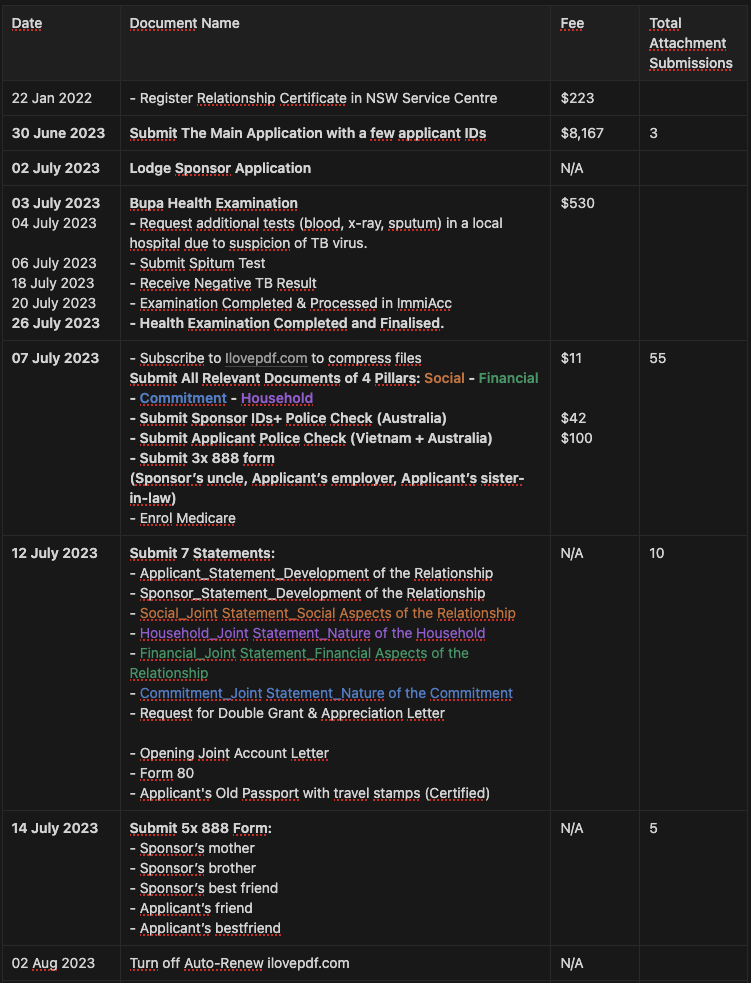
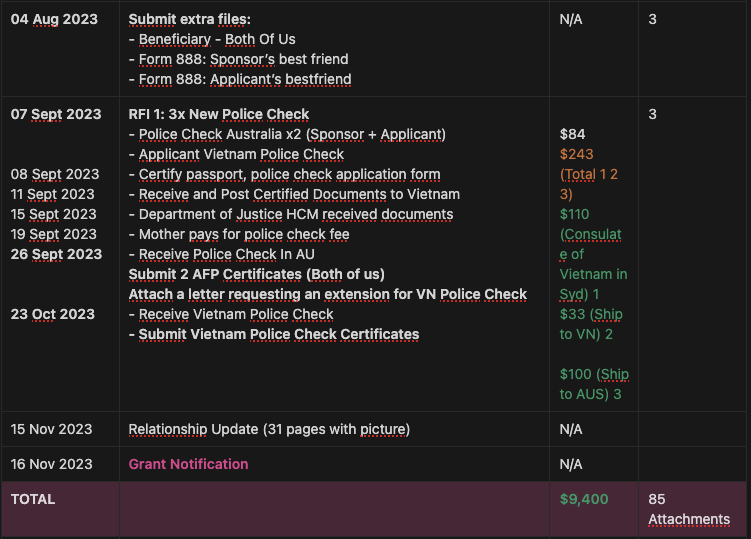
HOW I ORGANIZED AND PREPARED MY PARTNER VISA EVIDENCE
1. Introduction: Our Journey & Why Evidence Matters
- When I started the Partner Visa Subclass 820/801 process, we honestly didn’t expect how much it would demand from us. Initially, we thought it would just involve filling out forms and sending in a few documents. But as we got deeper into it, we realized that gathering evidence is at the heart of the application, and it’s far more than just paperwork—it’s about proving the genuineness of your relationship to people who’ve never met you.
- I remember feeling overwhelmed as we started collecting every shred of proof—bank statements, photos, texts, emails, and more. It wasn’t just about showing we were living together; we had to paint a clear picture of our lives as partners in every aspect—financially, socially, and emotionally.
- What I learned quickly was that strong evidence isn’t just important; it’s crucial. The immigration department wants to see tangible proof that your relationship is real and ongoing. For us, this meant providing details that we hadn’t thought of at first—like old rental agreements, joint expenses, and even messages from friends about us as a couple.
- The whole process was like putting together a puzzle of our life together. It wasn’t always easy, but looking back, it was a chance to reflect on how much we had grown as a couple. The stronger your evidence, the clearer your story becomes, and that’s what helps immigration officers understand the depth of your relationship.
2. Step-by-Step Guide to Preparing Evidence
Step 1: Research & Understand Visa Requirements
– Overview of definition and government requirements for the 820/801 visa.
- What is the Partner Visa (Subclass 820/801)?
- The Partner Visa Subclass 820/801 allows the spouse or de facto partner of an Australian citizen, Australian permanent resident, or eligible New Zealand citizen to live in Australia. This visa involves a two-stage process:
- What is the Partner Visa (Subclass 820/801)?
- Stage 1 – Partner or Prospective Marriage Visa (300, 309/100, 820/801), Subclass 820 (Temporary Visa): This allows you to stay in Australia temporarily while your permanent visa application is being processed. You can work, study, and enroll in Medicare (Australia’s public health system).
- Stage 2 – Subclass 801 (Permanent Visa): This is the second stage and grants you permanent residency if your relationship is still ongoing two years after lodging the initial application.
When we first started this journey, I didn’t realize how much time and emotional investment it would take. But once we completed the 820 stage, the sense of relief was huge, and the final goal of permanent residency felt much closer.
– Eligibility: Are You Ready?
Before you even start thinking about paperwork, make sure you and your partner meet the eligibility criteria. Trust me, it’s worth sitting down together and going through the list so you can plan your application process from the beginning.
- Relationship: You need to prove that your relationship is genuine and ongoing. It’s not just about being married or living together; it’s about showing that you share a life in all aspects—financial, social, and emotional.
- Sponsor: Your partner (sponsor) must be an Australian citizen, permanent resident, or eligible New Zealand citizen.
- Residence: If you’re applying as a de facto couple, you must have lived together for at least 12 months unless there are special circumstances, like registering your relationship.
For us, the relationship timeline was crucial. We spent an evening together reviewing when we started living together, opening a joint account, and planning our future. It helped us organize our documents and gave us confidence when we began collecting evidence.
When applying for a Partner Visa (Subclass 820/801), you may reach a point where you wonder if you should seek the help of a migration agent or rely on government resources. Here’s some advice to help you decide the best approach:
- Using Government Resources
- The Australian Department of Home Affairs provides a wealth of official information regarding visa applications. These resources are highly reliable, free, and up-to-date. If you prefer a DIY approach and feel confident navigating complex forms and evidence requirements, government resources may be enough for you.
- Benefits of Government Resources:
- Accuracy: The information is straight from the source, ensuring you have the most current visa requirements.
- Detailed Guides: Home Affairs offers step-by-step instructions on lodging applications and required documentation.
- Cost-Effective: You won’t need to pay for third-party services.
- Where to Access:
- Partner Visa 820/801 – Department of Home Affairs
- ImmiAccount portal for submission and tracking of your application.
- Challenges:
- Government guidelines can sometimes be overwhelming or too general, especially for complex cases. You’ll need to do a lot of reading and self-management.
- Using Government Resources
- Consulting a Migration Agent
If your case is complicated or you feel uncertain about the process, consulting a registered migration agent can provide personalized help. Migration agents are professionals who can help manage your application, ensure all paperwork is correctly submitted, and advise on tricky areas like proving the genuineness of your relationship.
- Benefits of Consulting a Migration Agent:
- Expert Guidance: They are familiar with the process, and they can point out missing or incomplete documentation.
- Tailored Advice: If your situation is unique (e.g., previous visa refusals, health or character issues), an agent can provide solutions specific to your case.
- Reduced Stress: They handle the complex aspects, which can help reduce the stress of the application process.
- How to Find a Registered Migration Agent:
- Use the Migration Agents Registration Authority (MARA) website to verify agents and find professionals with good reputations.
- Make sure they are registered to avoid dealing with unqualified or fraudulent individuals.
- Costs:
- Migration agents do charge for their services, and fees can range anywhere from AUD 2,000–10,000 depending on the complexity of your case.
- Benefits of Consulting a Migration Agent:
– When to Choose a Migration Agent
- You are unsure whether your evidence is strong enough.
- Your case involves complicated legal matters, such as previous visa refusals or health/character concerns.
- You are stressed by the complexity of the visa process and need professional guidance.
– When to Use Government Resources
- Your relationship and visa situation are straightforward, and you are comfortable following detailed written instructions.
- You want to save money and are willing to invest time into carefully researching and gathering evidence.
- You are confident in handling complex administrative processes.
In short, whether to use a migration agent or rely on government resources depends on how complex your case is and how comfortable you feel managing the process independently. For some, the peace of mind that comes with professional help is worth the cost, while others may prefer to handle things on their own with the help of official resources.
Step 2: Establish Key Dates and Timelines
- How to Establish Your De Facto/Marriage Relationship Start Date
Establishing the start date of your de facto or marriage relationship is one of the key pieces of information you’ll need for your Partner Visa (Subclass 820/801) application. Immigration officers use this to understand how long you’ve been in a committed relationship and whether it meets the visa criteria.
For a de facto relationship, immigration generally requires that you have been living together for at least 12 months before applying, unless your relationship is registered in an Australian state or territory. However, even with registration, proving the genuine start of your relationship can help strengthen your case.
Here’s how you can determine your relationship start date:
- Defining Your Relationship Start Date
- For De Facto Couples: This is typically the date you began living together as a couple, but it could also include when you started sharing financial commitments or made significant decisions about your future together. Immigration looks for evidence that reflects the “cohabitation” aspect of your relationship.
- For Married Couples: The relationship start date can be marked by your wedding day, though you might also include earlier milestones if you were living together or engaged before marriage. Documenting the time before marriage can add context to your relationship story.
- Determine Key Dates to Consider for De Facto Couples:
- The day you moved in together.
- The date you opened a joint bank account.
- Significant moments like when you made shared financial commitments (renting/buying property together).
- Any shared life events (holidays, family gatherings, etc.) where you were seen as a couple.
- When your relationship was acknowledged by friends and family.
- Creating a Detailed Timeline of Key Relationship Milestones
- Once you’ve established the start date, it’s important to create a timeline of key milestones that will help immigration understand the evolution of your relationship. This will make it easier to align your evidence with the important moments in your relationship, giving a clear picture of how your lives have become interconnected.
- Here’s how to create a detailed timeline:
- Break Down Your Relationship Into Stages:
- Initial Phase: When you first started dating, began getting to know each other, and spent time together socially. Include early photographs, messages, or emails from this time if available.
- Moving In Together: If you’re in a de facto relationship, this is one of the most important stages. Include your rental agreements, joint household bills, and any evidence showing shared residence.
- Financial Milestones: Did you open a joint bank account? Purchase something big together? Share financial commitments like bills, groceries, or rent? Provide documents for each event and mark these moments on the timeline.
- Social Integration: Show how your relationship is recognized by others. This could include attending family functions together, traveling as a couple, or being invited to events as a unit. Social media posts, messages, and invitations from family and friends can help demonstrate this aspect.
- Major Life Events: Engagement, marriage, the birth of children, or joint decisions like buying a house are all major milestones that should be included in your timeline. Photographs, receipts, and announcements from these events are crucial.
- Collect Evidence for Each Milestone
- As you build the timeline, gather evidence that aligns with each key event. This could include:
- Photos: From different stages of your relationship.
- Travel documents: Flight itineraries, hotel bookings, or photos from trips you’ve taken together.
- Social Media Evidence: Screenshots of posts or interactions that show your relationship is recognized by friends and family.
- Statements from Family and Friends (Form 888): These statutory declarations from people who know you as a couple can help provide context to your timeline.
- As you build the timeline, gather evidence that aligns with each key event. This could include:
- Make It Clear and Concise
- Create a simple timeline document that includes dates and corresponding pieces of evidence. You can create a table format that shows:
Date | Event | Evidence |
June 2017 | Started relationship | Photos, messages, first trip together |
June 2020 | Moved in together | Lease agreement, joint bills |
Dec 2022 | Decided to lodge Partner Visa 820/801 | Conversations, research, consultations |
Nov 2023 | Received double grant | Outcome emails, visa documents |
- Keep it Updated
- Even after submitting your application, keep track of any significant events that occur while you’re waiting for your visa to be processed. You may be asked for additional information or updates, so continuing to track your timeline will help ensure your evidence is always up-to-date.
- By organizing your evidence into a well-documented timeline, you not only create a clear picture of your relationship’s progression but also make it easier for the immigration officers to follow your story. This can significantly strengthen your Partner Visa application and help build a compelling case for your genuine relationship.
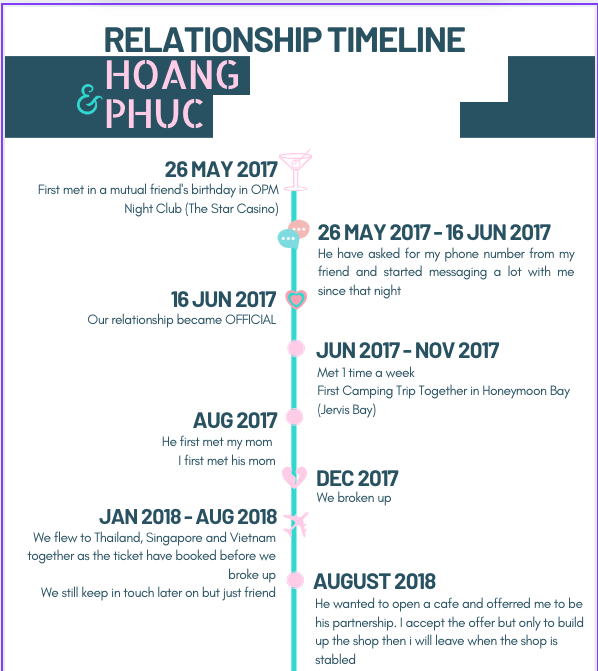
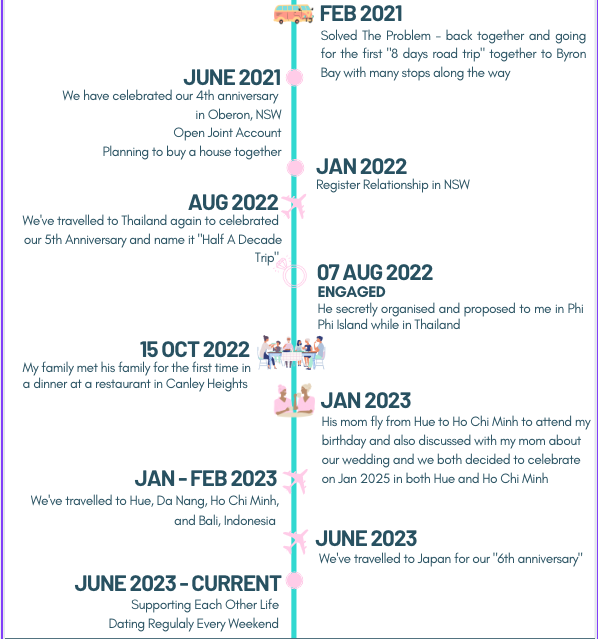
Step 3: Categorizing Your Evidence
The Partner Visa 820/801 process is all about proving that your relationship is genuine and ongoing. To do this effectively, you’ll need to gather and categorize evidence in a way that tells a coherent story about your life as a couple. Organizing this evidence into clear categories—Commitment, Financial Aspects, Household, Social, and Character—will not only help your application but also make it easier for the case officer reviewing it. Below is a detailed breakdown of how to categorize each type of evidence and why it’s important.
- Commitment: Demonstrating the Depth of Your Relationship
This category is about showing that your relationship is built on commitment, and not just convenience or a short-term arrangement. Immigration will be looking for evidence that you and your partner see a future together, and that your relationship is long-term.
Key Evidence to Include:
- Personal Statements:
- Both you and your partner will need to write detailed personal statements outlining the history of your relationship. This is your chance to tell your story. Talk about how you met, how your relationship developed, and the challenges and joys you’ve faced together. Highlight important moments like when you decided to live together, discuss future plans, and share why you’re committed to each other for the long term.
- Tip: Include emotional and real details to make it more relatable. Don’t just list dates—focus on personal experiences that reflect your relationship’s depth.
- Engagement and Marriage Plans (if applicable):
- If you’re engaged or married, include the relevant documents, such as engagement announcements, wedding invitations, or booking confirmations. Even if your wedding hasn’t happened yet, showing that you’ve made plans to get married can demonstrate your commitment.
- Future Plans:
- Documents that demonstrate your future together, such as travel bookings, plans to buy property, or even conversations about having children. This shows that you’re planning a shared future and not just focused on the short-term.
- Long-Term Financial Commitments:
- If you’ve made significant financial commitments together, such as naming each other as beneficiaries on insurance policies, including each other in wills, or opening joint savings accounts for long-term goals (e.g., retirement or travel), include these documents to show the seriousness of your relationship.
Why This Is Important:
The government needs to see that your relationship isn’t just based on cohabitation or convenience, but rather on emotional and practical commitment. These documents help prove that you’re in it for the long haul.
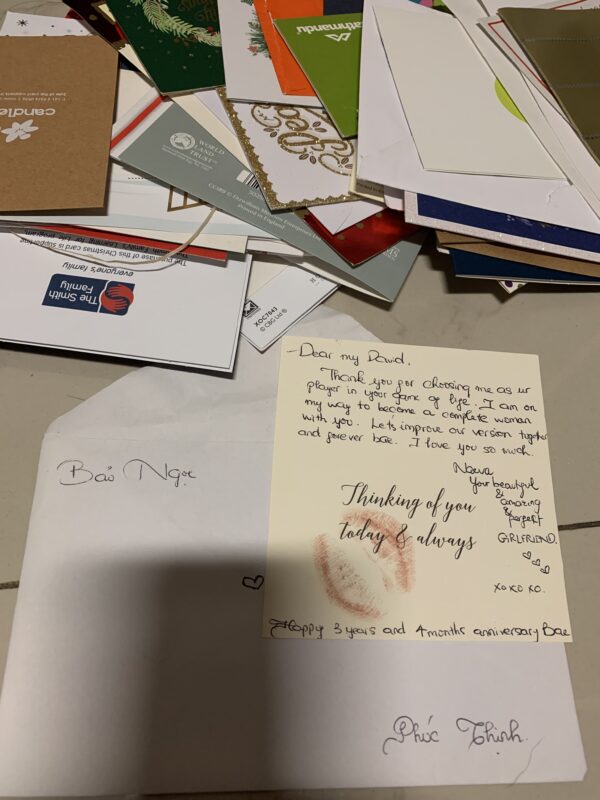
- Financial Aspects: Demonstrating Financial Interdependence
Financial evidence is crucial because it shows that you and your partner share financial responsibilities, which is a key indicator of a genuine relationship. Immigration looks for evidence that your lives are financially intertwined.
Key Evidence to Include:
- Joint Bank Accounts:
- Providing joint bank account statements is one of the strongest pieces of evidence you can submit. It shows that you manage your finances together and share the burden of household expenses. Ensure you provide statements that cover at least 6-12 months.
- Tip: Highlight transactions related to joint expenses, like rent, bills, or shared purchases with captions.
- Shared Expenses:
- Evidence of shared expenses like utility bills, rent, groceries, insurance, and household purchases can demonstrate financial interdependence. If you don’t have a joint bank account, you can still show how you share the financial load by providing evidence of payments made on behalf of one another.
- Include evidence of split bills, receipts for joint purchases, and invoices that show both your names (if applicable).
- Big Purchases:
- Documents for significant purchases made together, such as buying a car, furniture, or household appliances, are great evidence. These show that you’re not only living together but also investing in a shared future.
- Include purchase receipts or contracts that bear both your names, or proof of payment from your joint account.
- Loans and Mortgages:
- If you have a mortgage or joint loan, include evidence of this, as it’s a strong indicator of financial interdependence. Loan agreements or mortgage documents that show both names are highly valuable in demonstrating shared responsibility and long-term planning.
Why This Is Important:
Sharing finances and being financially interdependent is a key aspect of a genuine partnership. Immigration wants to see that you’re pooling your resources and relying on each other financially, which is a strong indicator of commitment.
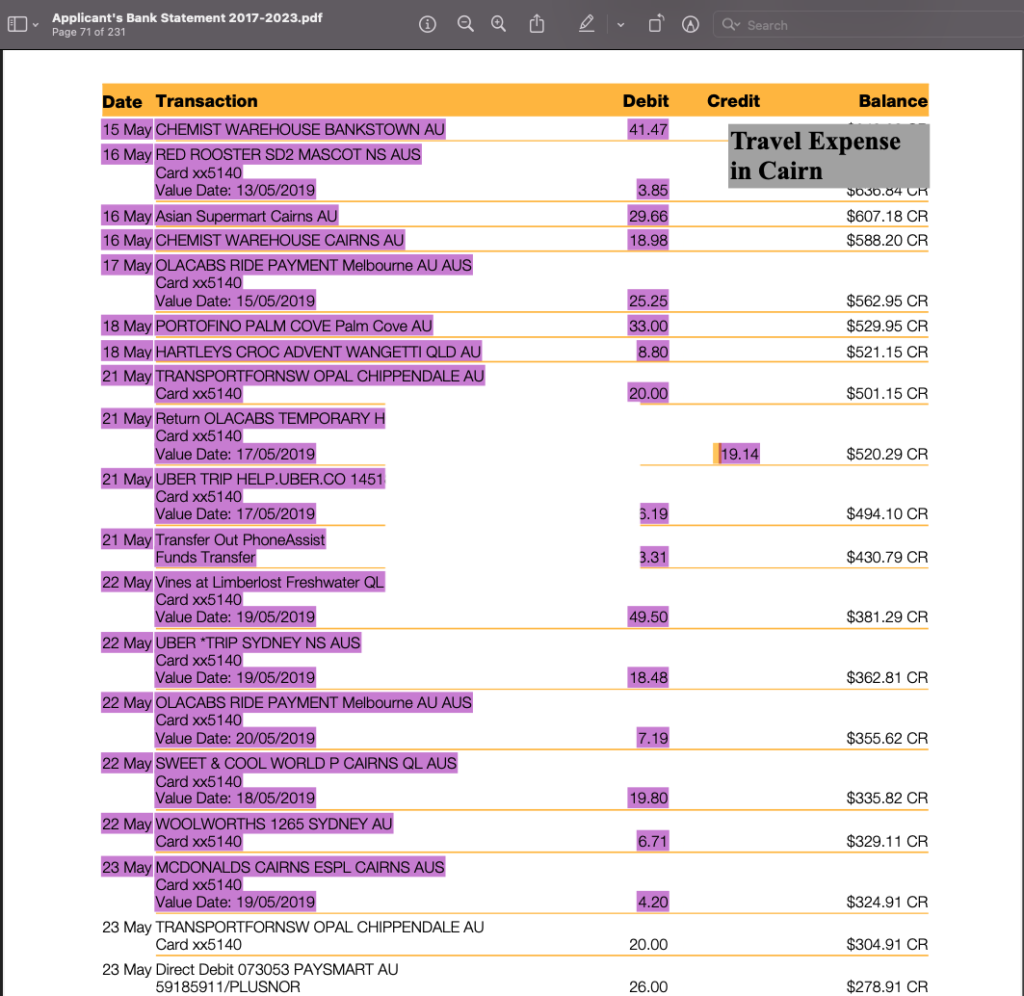
- Household: Demonstrating Shared Living Arrangements
Proving that you live together is critical. Immigration will expect to see clear evidence that you share a home and daily life as a couple.
Key Evidence to Include:
- Lease Agreements:
- Include any rental agreements or contracts that show both your names as tenants. If your lease only has one name on it, provide other evidence (like utility bills) to show that you both live at the same address.
- If you’ve renewed your lease together, provide the updated version as well. The longer you’ve lived together, the better.
- Utility Bills:
- Submit utility bills (electricity, gas, water, internet) addressed to both of you. If only one person’s name is on the bill, show that the other is making contributions by providing bank statements or receipts that correspond to bill payments.
- Mail Addressed to Both of You:
- Any official mail (such as bank statements, insurance documents, or government correspondence) sent to your shared address can serve as evidence that you live together. It’s especially useful if both your names are on the same piece of mail.
- Photos of Your Shared Home:
- While not a requirement, photos of your shared home can add a personal touch to your application. Include pictures of rooms you’ve furnished together or areas where you spend time as a couple.
Why This Is Important:
Immigration needs proof that you’re sharing a life together in the same household, not just visiting or staying temporarily. This evidence helps show that your relationship is stable and grounded in everyday life.
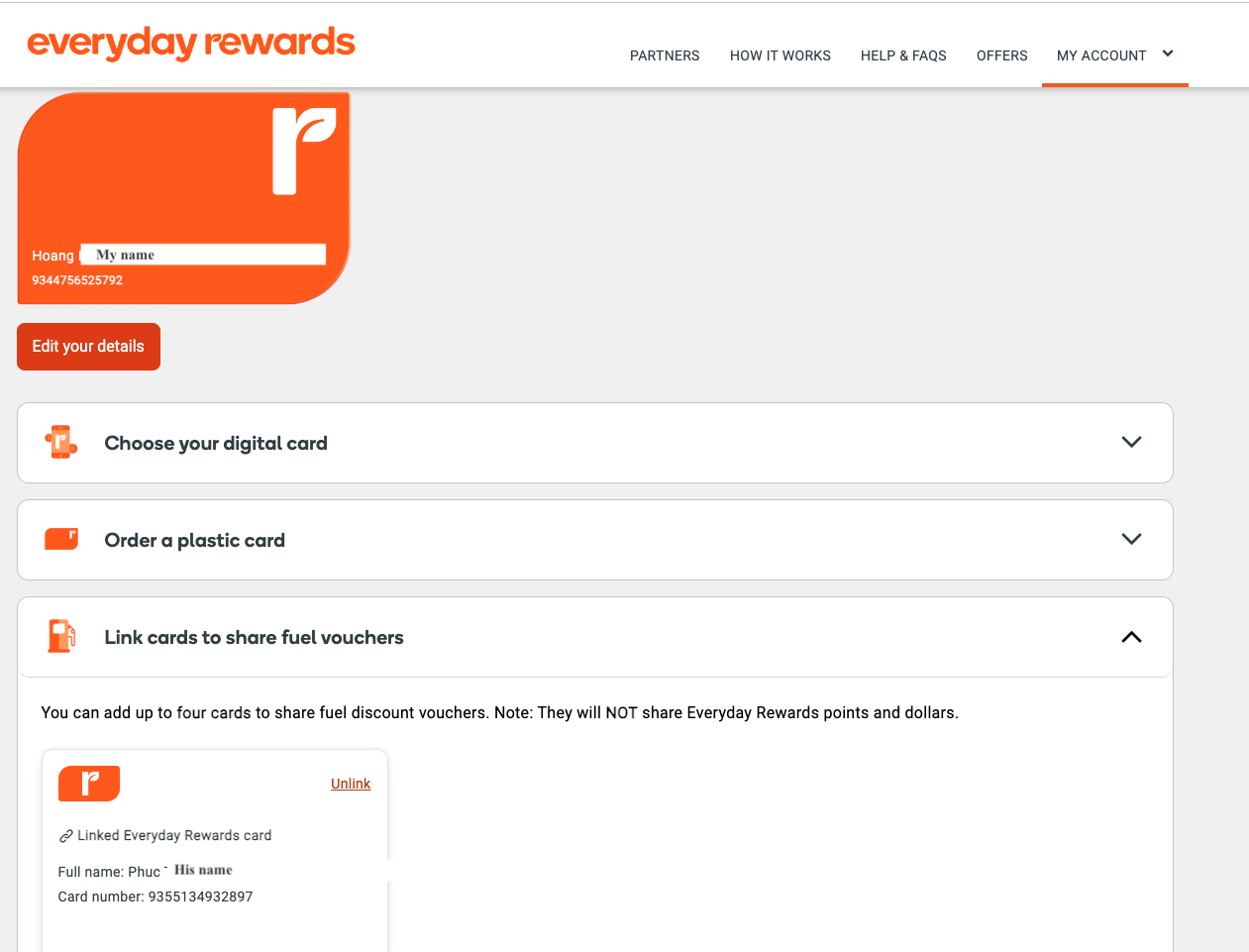

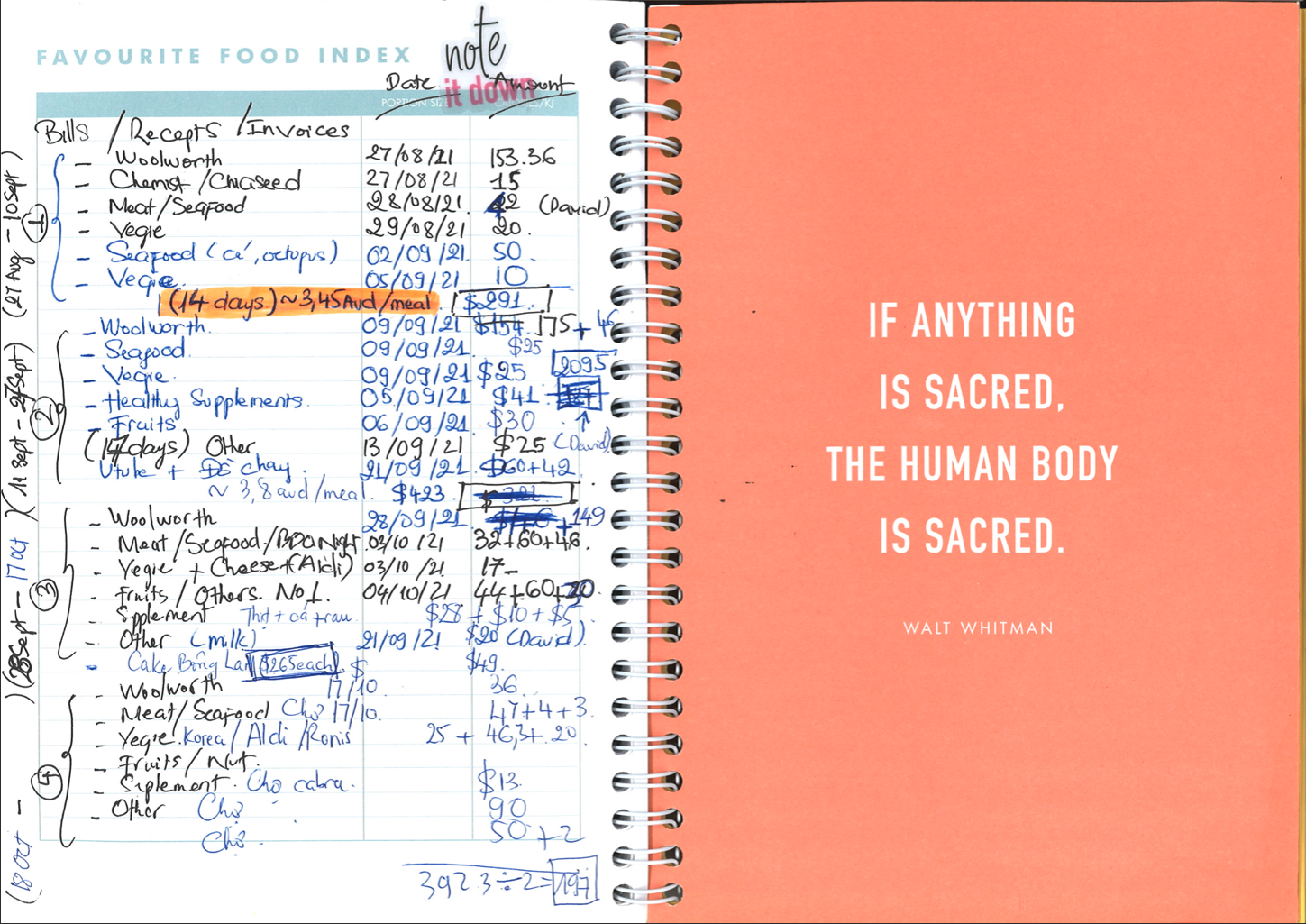
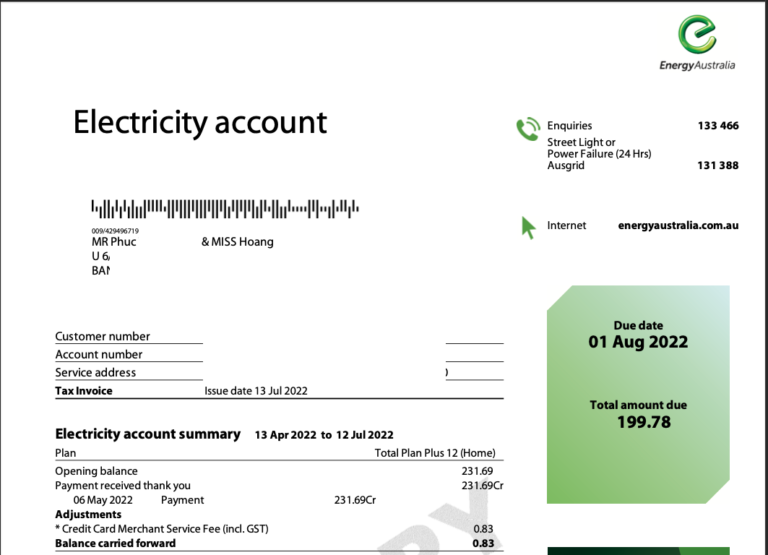
- Social Aspects: Demonstrating Social Recognition of Your Relationship
This category focuses on showing that your relationship is known and recognized by friends, family, and your community. It helps to prove that you’re a real couple, not just in private but also in public.
Key Evidence to Include:
- Photos Together:
- Include photos of you and your partner at events, family gatherings, and social occasions. Try to select photos that show a variety of dates and locations to demonstrate that you’ve been a couple for a long time. Photos with friends and family are especially helpful.
- Tip: Group photos are valuable because they show that your relationship is recognized by others.
- Social Media Posts:
- Screenshots of social media posts where you’ve been tagged or where friends have commented on your relationship can serve as informal but useful evidence.
- Include screenshots of interactions on Facebook, Instagram, or other platforms that demonstrate that your relationship is public knowledge.
- Invitations to Events:
- If you’ve been invited to events like weddings, parties, or family gatherings as a couple, include copies of these invitations. They show that your relationship is acknowledged by the people closest to you.
- Statutory Declarations (Form 888):
- Ask your friends and family members to complete Form 888 statutory declarations attesting to the genuineness of your relationship. These declarations should be written by people who have known both you and your partner for some time and can vouch for the strength of your relationship.
- Tip: Make sure they’re filled out in detail and address how your relationship has evolved.
Why This Is Important:
Social evidence demonstrates that your relationship isn’t just something private but is known and recognized by others. It helps show that your partnership is genuine and integrated into your community.
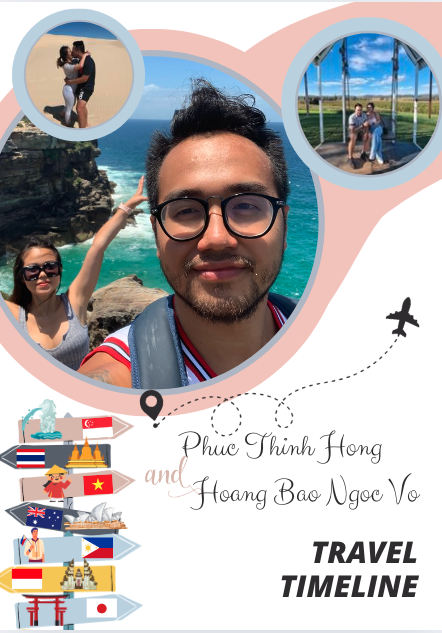

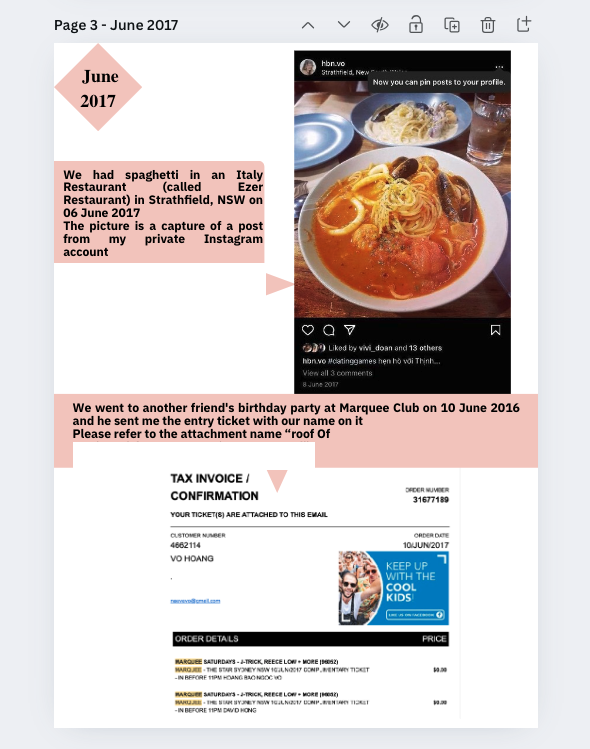
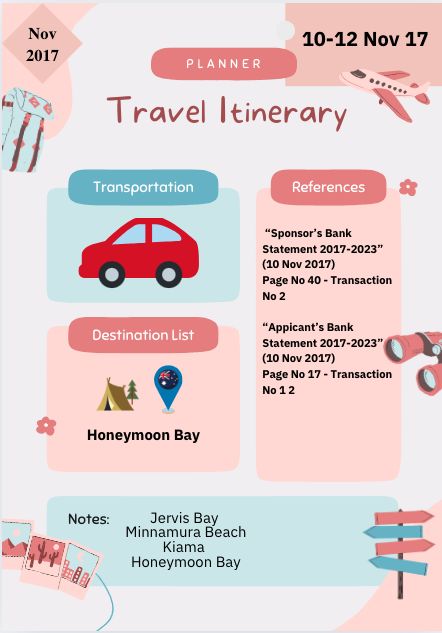
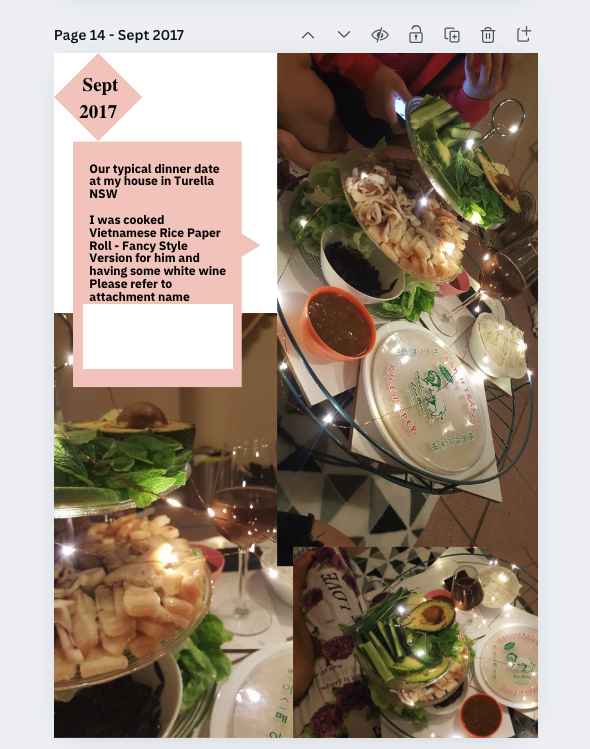
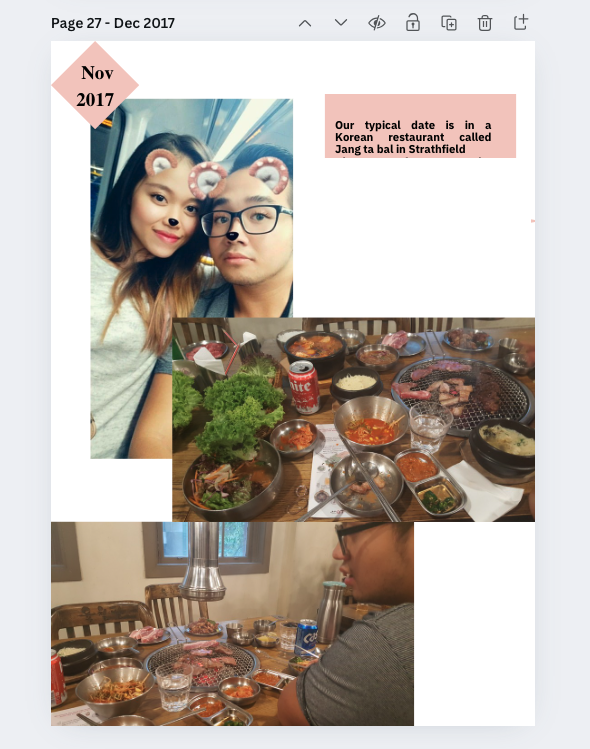

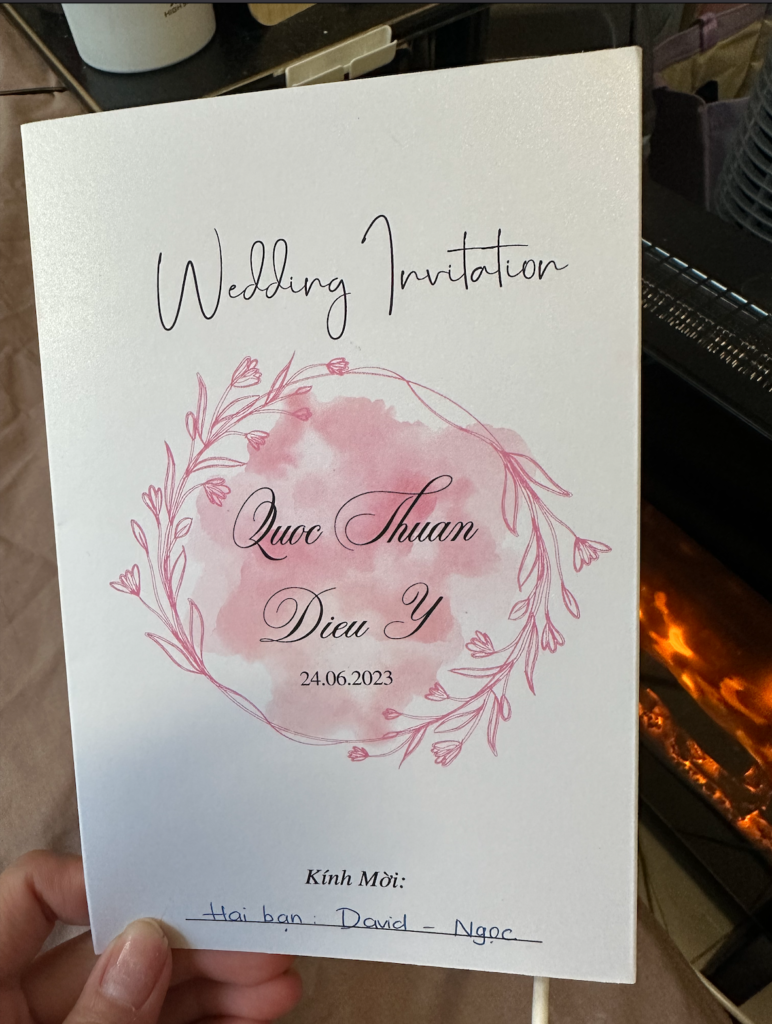
- Evidence of Character: Demonstrating Good Standing
Finally, immigration will require evidence of good character from both you and your partner. This involves submitting legal and health-related documents to ensure that both of you meet Australia’s character requirements.
Key Evidence to Include:
- Police Checks:
- You’ll need to provide police clearance certificates from every country you’ve lived in for more than 12 months over the past 10 years. This is to demonstrate that you don’t have any serious criminal records. Be sure to get up-to-date certificates before submitting your application.
- Health Examinations:
- After lodging your application, you’ll need to undergo a health examination. The results will be automatically uploaded to your visa application through the medical panel, so make sure to book the appointment as soon as possible after applying.
- Court Documents (if applicable):
- If you or your partner have any legal history that needs to be disclosed, include the relevant court documents and provide an explanation.
Why This Is Important:
Ensuring both you and your partner meet Australia’s character and health standards is a vital part of the visa process. Immigration needs to be assured that you are both fit to live in the country.
Step 4: Gathering and Organizing Documents
Organizing your documents efficiently is crucial to ensure your Partner Visa (820/801) application is both clear and comprehensive. Immigration officers must be able to quickly assess and understand your relationship timeline and supporting evidence, so having a methodical approach to document collection and organization will increase your chances of success.
Here’s how you can gather and organize your documents effectively:
- Creating Digital Folders for Each Category
To keep your documents organized, create separate digital folders for each category of evidence. This will help you and the immigration officers navigate through your relationship story with ease. I personally found this method invaluable as it prevented any confusion when it came time to upload everything.
Suggested Folder Structure:
- Commitment: Store your personal statements, future plans, engagement/marriage documents, and any long-term commitments such as wills, insurance policies, or beneficiary forms.
- Financial Aspects: This should include joint bank account statements, shared bills, receipts for joint purchases, mortgage or loan documents, and anything that reflects shared financial responsibility.
- Household: Include lease agreements, utility bills, shared mail, and any proof of your living arrangements. If you have photos of your shared home, add those as well.
- Social: This is where you’ll store social evidence, including photos of you as a couple with family and friends, social media posts, invitations to joint events, and statutory declarations (Form 888) from people who can vouch for your relationship.
- Character: Store police clearance certificates, health examinations, and any other legal documents related to your and your partner’s character.
By keeping these folders well-organized, you’ll make it easier for yourself to track what documents you have and what’s still missing. It also makes it straightforward to upload to ImmiAccount, as you can find everything quickly.
- Using Timelines to Align Documents to Key Dates
Creating a timeline of your relationship is extremely helpful. It allows you to align your evidence with important milestones, ensuring that your documents tell a consistent story. Timelines not only help you stay organized but also provide immigration officers with a clear narrative of how your relationship has evolved.
How to Create a Timeline:
- Step 1: List Key Relationship Milestones
Start by listing major events in your relationship: when you first met, moved in together, opened a joint bank account, got engaged, or made long-term plans. Be as detailed as possible, and include dates for each event. - Step 2: Align Documents to Each Milestone
After listing these milestones, go through your documents and align them with these events. For example:- Moving in Together: Lease agreement, utility bills from that period.
- Opening a Joint Bank Account: First joint account statement, receipts for shared purchases around that time.
- Family Gatherings or Holidays: Photos, flight tickets, or itineraries from those trips.
- By aligning documents with these key dates, you’re showing immigration officers that your relationship has progressed naturally and that your evidence backs up the timeline.
- Step 3: Use Excel or Google Sheets to Track
I found it really useful to create a simple spreadsheet (either in Excel or Google Sheets) where I listed the milestones in one column and the corresponding evidence in another. This way, I could easily see which documents were associated with each date.
Here’s an example of how your timeline might look:
Date | Event | Corresponding Evidence |
June 2017 | Began relationship | Photos from early dates and social events |
June 2020 | Moved in together | Lease agreement, utility bills, joint mail |
Dec 2022 | Joint bank account opened | First joint bank statement, shared purchases |
Nov 2023 | Double visa grant received | Outcome emails, visa grant letters |
- Including Checklists for Document Types
Checklists are incredibly helpful to ensure that you don’t miss any important documents. By keeping track of what you’ve gathered and what’s still needed, you can systematically check off items as you go. This is particularly useful when managing a large volume of evidence.
Suggested Checklist for Partner Visa Documents:
Here’s an example of how you could structure your checklist:
Category | Document | Collected ( |
Commitment | Personal statement from both partners | |
Future travel plans | ||
Wills/insurance beneficiaries | ||
Financial | Joint bank account statements (6-12 months) | |
Shared utility bills | ||
Lease agreement | ||
Mortgage/loan documents | ||
Household | Photos of shared home | |
Mail addressed to both partners | ||
Social | Photos of couple at family events | |
Statutory declarations (Form 888) | ||
Character | Police clearance certificate (both partners) | |
Health examination results |
This kind of checklist ensures that you’re staying organized and aware of what’s still needed. It’s a great tool to use as you continue gathering evidence.
Practical Tips for Managing Your Documents
- File Naming Convention: Use a clear naming convention for all your documents. For example:
- “Joint_Bank_Statement_June2020”
- “Lease_Agreement_June2020”
- “Form888_JohnSmith_Sponsor’sBrother”
This makes it easier for both you and the immigration officer to identify the document at a glance.
- Scans and PDF Format: Ensure that all your documents are scanned at a high resolution and saved in PDF format. Immigration prefers PDFs for easier uploading and reviewing. Double-check that all scans are clear and readable.
- Backup Your Documents: Save copies of your organized files in multiple locations—on your computer, an external hard drive, or a cloud service like Google Drive or Dropbox. This will ensure you don’t lose anything if your primary storage fails.
- Continuous Updates: Keep updating your folders as your relationship progresses, especially during the waiting period after lodging the application. Immigration might request additional documents (RFI – Request for Further Information), so having everything already organized and updated will save you time and stress.
Gathering and organizing documents for your Partner Visa can feel overwhelming, but having a clear system makes the process much more manageable. By creating digital folders, aligning your documents with a timeline, and using checklists, you’ll not only keep yourself organized but also make the immigration officer’s job easier. In turn, this increases the chances of a smoother, faster application process.
Remember, the key is to tell a clear, coherent story about your relationship. By organizing your evidence thoughtfully and systematically, you’re helping the immigration officers see the full picture of your life together.
Step 5: Writing Strong Relationship Statements
One of the most important parts of your Partner Visa (820/801) application is the relationship statement—both from you and your partner. These statements are a personal account of your relationship and provide context to the evidence you’re submitting. It’s a chance to tell your story in your own words and explain why your relationship is genuine, committed, and ongoing.
Here’s how to structure your personal and partner’s relationship statements and the key points to include:
- Structure of a Relationship Statement
- To make your statement clear and easy to follow, break it into the following sections:
- 1.1. Introduction
- Basic Information: Start with your full name, date of birth, and details about your partner (full name and date of birth).
- Length of Relationship: State how long you’ve been together and the significant dates (e.g., when you first met, moved in together, got married).
- Purpose: Briefly mention that you’re writing this statement to support your application for a Partner Visa.
- 1.1. Introduction
Example:
“My name is [Your Name], and I was born on [Date of Birth]. I have been in a committed relationship with [Partner’s Name], who was born on [Date of Birth], since [date you began your relationship]. We are applying for the Partner Visa (820/801) to continue building our life together in Australia.”
- 1.2. How You Met
- Details of First Meeting: Describe how and where you met, including the circumstances and who introduced you (if applicable). Mention what drew you to each other in the beginning.
- First Impressions: Include a personal touch about your first impressions of your partner. Were there any particular qualities that stood out to you?
- 1.2. How You Met
Example:
“[Partner’s Name] and I first met in [Month, Year] at [location/event], introduced by a mutual friend. We instantly connected over our shared love for [interest/hobby]. I was struck by [Partner’s Name]’s [quality, e.g., kindness or sense of humor], and we quickly realized that we had a strong connection.”
- 1.3. The Development of Your Relationship
- Early Stages: Talk about how your relationship developed over time. Mention key moments like your first date, trips taken together, meeting each other’s families, or moving in together.
- Milestones: Include significant events, such as anniversaries, living arrangements, travel experiences, and shared responsibilities (e.g., getting a pet or managing a home).
- Challenges and Growth: If you’ve faced any challenges together (e.g., long-distance, health issues, or immigration hurdles), talk about how these experiences have made your relationship stronger.
- 1.3. The Development of Your Relationship
Example:
“After we started dating, our relationship progressed naturally. We spent a lot of time together, and in [Month, Year], we decided to move in together. This was a big step for both of us, and living together deepened our bond. We’ve also taken several trips together, including [destination], which gave us the chance to learn more about each other’s interests and habits.”
- 1.4. Financial and Living Arrangements
- Shared Finances: Mention how you manage your finances, including any joint bank accounts, shared bills, or big purchases you’ve made together (e.g., a car, furniture, or a house).
- Living Together: Detail your current living situation. Mention the date you moved in together and include specifics about your shared home, how you split household responsibilities, and how long you’ve been living together.
- 1.4. Financial and Living Arrangements
Example:
“We officially moved in together on [Date], and since then, we’ve shared financial responsibilities such as paying rent, bills, and groceries. We opened a joint bank account in [Month, Year] and use it to manage our household expenses. Living together has brought us closer, and we’ve created a warm, supportive home environment.”
- 1.5. Future Plans
- Short and Long-Term Goals: Explain what plans you and your partner have for the future. This could include plans to buy a house, get married (if not already), start a family, travel, or other significant commitments.
- Building a Life Together: This section should show that your relationship is forward-looking and that you are planning a shared life in Australia.
- 1.5. Future Plans
Example:
“We have exciting plans for the future, including traveling to [destination] next year and eventually purchasing a home together in [city]. We both share a vision of building a life here in Australia, and we’re excited about starting a family in the coming years.”
- 1.6. Conclusion
- Affirmation of Your Commitment: End your statement by reaffirming your commitment to each other and your relationship’s long-term nature. Express why you’re applying for the Partner Visa and how it will help you continue your life together.
- 1.6. Conclusion
Example:
“In conclusion, I believe that our relationship is built on mutual love, respect, and trust. We are fully committed to spending our lives together, and this visa will allow us to continue building our future in Australia. Thank you for considering our application.”
- Key Points to Include
- When writing your relationship statement, ensure that you address the following key points:
- 2.1. How You Met
- Where, when, and how you met (include specific details).
- First impressions and what attracted you to each other.
- 2.2. Major Milestones
- Key moments in your relationship (moving in together, getting engaged/married, etc.).
- How your relationship developed over time (meeting each other’s families, shared experiences).
- 2.3. Challenges You’ve Overcome
- Any obstacles you’ve faced together and how they strengthened your relationship.
- Examples might include long-distance periods, health issues, or external challenges like the visa process itself.
- 2.4. Financial Interdependence
- Joint financial decisions like opening a bank account, sharing bills, and making big purchases.
- Any investments or significant financial commitments made as a couple.
- 2.5. Living Arrangements
- Where you live, how long you’ve lived together, and how you manage the household.
- Whether you rent or own your home, and how responsibilities are shared.
- 2.6. Future Plans
- Your short and long-term goals as a couple.
- Shared dreams such as traveling, buying a home, starting a family, or other future projects.
- 2.1. How You Met
Final Tips
- Be Honest: Be genuine in your writing. Immigration officers want to see a real, relatable story—not just a rehearsed version of events.
- Be Detailed but Concise: Include specific details about your relationship but avoid unnecessary repetition. Focus on the points that matter.
- Support Your Statements with Evidence: Mention any evidence you’ll be including in your application (e.g., receipts, photos, joint bank statements).
- Make It Personal: This is your chance to share the unique aspects of your relationship. Include small, personal details that make your story stand out.
Writing a strong relationship statement can feel daunting, but if you structure it well and include these key points, you’ll have a clear, compelling story that reflects the genuine nature of your relationship.
Step 6: Form 888 & Supporting Statements from Friends/Family
When applying for the Partner Visa (Subclass 820/801), you’ll need to collect Form 888 statutory declarations from friends or family members to support your claim that your relationship is genuine and ongoing. These declarations provide third-party confirmation from people who know you as a couple and can vouch for your relationship.
Here’s a guide on how to request and collect Form 888 and help your friends and family write clear, supportive statements.
- What is Form 888?
- Form 888 is a statutory declaration completed by Australian citizens or permanent residents who know you and your partner and can confirm the genuineness of your relationship. The form asks for details about how the declarant knows you both and how long they’ve known about your relationship.
- Key Points:
- Form 888 is a legal document that must be completed truthfully.
- It should only be filled out by people who have a close, personal understanding of your relationship, such as family members or close friends.
- It can only be completed by Australian citizens or permanent residents, though you can also submit similar declarations from overseas friends and family as separate statements.
- How to Request Form 888 from Friends/Family
- Requesting Form 888 might feel awkward, but it’s a necessary step in the visa process. Approach your friends and family early, giving them plenty of time to fill out the form and get it certified.
- Step-by-Step Guide to Requesting Form 888:
- Choose the Right People:
- Select people who have known both you and your partner for an extended period and who have witnessed your relationship from the beginning.
- Ideally, these should be people from different aspects of your life—family members, close friends, and maybe even a colleague—so the immigration officer gets a well-rounded perspective of your relationship.
- Explain the Importance:
- Let your friends/family know why their input is crucial for your visa application. Explain that Form 888 helps to confirm that your relationship is genuine and recognized by those around you.
- Provide Instructions:
- Send them a link to Form 888 and explain how to fill it out. If they’re unfamiliar with the visa process, walk them through what needs to be included.
- Attach helpful resources (such as a guide on how to complete Form 888) and a summary of the key points they should include based on their knowledge of your relationship.
- Offer to Help:
- While they need to write the declaration themselves, offer to clarify any points or provide reminders of specific events or dates they may want to include.
- Remind Them About Certification:
- Remind them that the completed Form 888 must be signed and witnessed by an authorized person (a Justice of the Peace, lawyer, or notary) to be valid. This certification process is crucial.
- Collect the Forms:
- Make sure to collect the completed forms and check that they are properly signed and certified. Keep track of deadlines to ensure they’re submitted on time with your visa application.
- Choose the Right People:
- What to Include in a Form 888 Declaration
- Your friends and family should focus on being specific and honest when completing the form. Immigration officers want concrete examples and personal stories that demonstrate their knowledge of your relationship.
- Key Sections of Form 888:
- How Long They Have Known You:
Your friend or family member should mention how long they’ve known each of you and how they met you. - How Long They Have Known About Your Relationship:
This section should highlight when they first learned that you were in a relationship and the circumstances under which they realized your partnership was serious. - How They Have Seen Your Relationship Develop:
This is a key part of the form. Your friends/family should give examples of how they have witnessed your relationship grow and strengthen over time. They should describe specific events like:- Social gatherings where you attended as a couple.
- Holidays, family events, or celebrations where your relationship was visible.
- Conversations where you’ve shared future plans as a couple (e.g., moving in together, travel, children, etc.).
- Any Joint Activities They Have Observed:
Friends and family should provide evidence of joint activities like trips, shared social events, or times you’ve both been involved in supporting one another (e.g., during a crisis or significant life event).
- How Long They Have Known You:
Example Statement:
“I have known [Your Name] and [Partner’s Name] since they first began dating in [Year]. I first met them as a couple at a family BBQ in [Month, Year]. Since then, I have seen their relationship grow as they moved in together and supported each other through the challenges of living in a new city. They’ve always attended family functions as a couple, and it’s clear to me that they share a strong and loving relationship. I’ve also seen how they make joint decisions, including their plans to travel and build a life together in Australia.”
- Tips for Friends and Family on Writing Strong Statements
- Your friends and family might not know exactly what to write in their Form 888, so providing them with guidance is helpful. Here are some tips to pass along to them:
- Be Specific: Use concrete examples and anecdotes. General statements like “They’re a great couple” won’t be as helpful as specific memories that show the progression of your relationship.
- Mention Key Events: If they attended your engagement party, wedding, or a significant event like a holiday, they should mention these moments. These events help demonstrate the long-term and committed nature of your relationship.
- Keep It Personal: Encourage them to share personal observations. For example, if they saw you two supporting each other during difficult times, they should mention this. These personal touches make the declaration feel more genuine.
- Stick to What They Know: It’s important that friends and family only comment on aspects of your relationship they’ve directly witnessed. They shouldn’t speculate or provide information they’re unsure about.
- Keep It Honest: Remind them that their statutory declaration is a legal document, so they need to ensure everything they write is true to the best of their knowledge.
- Witnessing and Certifying Form 888
- Once your friends or family have completed Form 888, they need to have it signed and witnessed by an authorized person. The list of people who can witness the form includes:
- Justice of the Peace
- Lawyer/Notary
- Police officer
- Pharmacist
- Registered Nurse
- You can find the full list of authorized witnesses on the Form 888 instructions provided by the Department of Home Affairs.
- After the form is witnessed, it can be returned to you for submission along with your other supporting documents.
Final Thoughts
Form 888 statutory declarations are a valuable part of your Partner Visa application, offering third-party confirmation of the authenticity of your relationship. By selecting the right people to fill out the form, providing clear instructions, and ensuring the statements are specific, personal, and honest, you’ll strengthen your visa application.
Make sure to gather these forms early and check that all documents are signed, witnessed, and returned before your submission deadline. A well-prepared Form 888 can add significant weight to your overall application, helping to show that your relationship is genuine and recognized by those around you.
Step 7: Proof of Good Character (Police Checks, Health Examinations)
One essential part of your Partner Visa (820/801) application is demonstrating that both you and your partner meet the character requirements. This involves obtaining police checks from the countries where you’ve lived and completing a health examination. Below is a step-by-step guide on how to obtain police checks from different countries and book your health examination.
- Obtaining Police Checks
- Police checks are required to demonstrate that both you and your partner meet Australia’s character requirements. You need to provide police checks from every country where you’ve lived for 12 months or more in the past 10 years.
- Step-by-Step Process for Obtaining Police Checks
- 1.1. For Australia (AFP National Police Check)
- If you’ve lived in Australia for 12 months or more, you’ll need a National Police Check from the Australian Federal Police (AFP).
- Step 1: Visit the Australian Federal Police website and complete the National Police Check application form.
- Step 2: Select the appropriate visa category in the form (e.g., “Commonwealth Employment/Purpose”).
- Step 3: Pay the application fee (approximately AUD $42).
- Step 4: Submit the form online and wait for your police check, which will typically be sent to you within 10-15 business days.
- Useful link: Australian Federal Police National Police Checks
- If you’ve lived in Australia for 12 months or more, you’ll need a National Police Check from the Australian Federal Police (AFP).
- 1.1. For Australia (AFP National Police Check)
- 1.2. For Other Countries
- If you’ve lived in any other countries for more than 12 months, you’ll need to obtain police clearance from each of them. The process varies depending on the country.
- Here’s a general process you can follow:
- Step 1: Visit the Department of Home Affairs website for information on how to obtain police checks from specific countries. They provide a list of countries and detailed instructions for each.
Useful link: Country-specific Police Check Instructions - Step 2: Follow the country-specific requirements for applying for a police check. This usually involves:
- Filling out a request form.
- Providing identification documents (passport, national ID).
- Paying the relevant application fee (if applicable).
- Step 3: Once you have received your police check, ensure it is translated into English by a certified translator if it’s in another language.
- Step 1: Visit the Department of Home Affairs website for information on how to obtain police checks from specific countries. They provide a list of countries and detailed instructions for each.
- Example of Obtaining a Police Check from Vietnam:
- For Vietnam, you can apply for a Judicial Certificate (Phieu Ly Lich Tu Phap) at the Department of Justice in the province where you last resided. Alternatively, you can apply through the Vietnamese consulate if you are currently abroad.
- Health Examinations
- Another requirement for your Partner Visa is passing a health examination to prove that you meet Australia’s health requirements. This process is mandatory for both you and your partner and must be completed through an approved panel physician.
- Step-by-Step Process for Booking and Completing a Health Examination
- 2.1. Booking Your Health Examination
- Step 1: After you’ve lodged your Partner Visa application, you’ll receive a Health Identifier (HAP ID) via ImmiAccount. This ID is necessary to book your medical examination.
- Step 2: Visit the Bupa Medical Visa Services website (or the panel physician’s website for your country) to book an appointment.
- For applicants within Australia, you can book through Bupa Medical Visa Services.
- For applicants outside Australia, use the panel physician search tool on the Department of Home Affairs website to find an approved clinic.
- 2.1. Booking Your Health Examination
- Useful link: Bupa Medical Visa Services
- Step 3: Schedule an appointment at the nearest clinic. Keep in mind that health examinations typically include:
- Chest X-ray (to check for tuberculosis).
- General health check (height, weight, blood pressure, etc.).
- Blood tests (to check for conditions like HIV).
- Step 3: Schedule an appointment at the nearest clinic. Keep in mind that health examinations typically include:
- 2.2. What to Expect During the Examination
- On the Day of Your Exam:
- Arrive with your HAP ID, passport, and any relevant medical history.
- The panel physician will conduct a basic physical examination, ask about your medical history, and perform the necessary tests.
- The doctor will upload your results directly to the Department of Home Affairs, so there’s no need for you to submit them yourself.
- After the Exam:
- You can track the status of your health examination in ImmiAccount. Once the Department of Home Affairs receives your results, they will notify you of the next steps (if any further health checks are needed).
- On the Day of Your Exam:
Final Thoughts
Completing your police checks and health examination is a crucial part of the Partner Visa process. Make sure to start these steps early, as they can take time depending on the country you’re obtaining police clearances from or the availability of health appointments. By following this guide and staying organized, you’ll be able to meet the character and health requirements efficiently, bringing you one step closer to successfully lodging your visa application.
3. Finalizing Your Application & Submitting
Once you’ve gathered all your evidence for the Partner Visa (Subclass 820/801), the final steps are to review everything carefully, ensure all documents are labeled correctly, and submit your application through ImmiAccount. This phase is crucial, as a well-organized and thorough submission can streamline the visa approval process. Here’s how to complete the final document review and submission process.
- Final Document Review & Submission Checklist
Before submitting your application, it’s important to review all your documents to make sure everything is in order. Here’s a checklist to help ensure your submission is complete:
Final Document Review Checklist:
- All Evidence Categories Covered:
- Ensure you’ve included evidence for all key areas: Commitment, Financial, Household, Social, and Character.
- Document Quality:
- Check that all scanned documents are clear and readable.
- All photos should be of high quality (not pixelated or blurry).
- Consistency:
- Review your documents to ensure that all dates and details match across evidence (e.g., the date you moved in together, joint bank account opening date, etc.).
- Completeness:
- Confirm that all required forms are included (e.g., Form 888 from friends and family, police checks, health examination results).
- Ensure each document is signed and certified where necessary.
- Translation:
- If any documents are in a language other than English, make sure you’ve included an official translation from a certified translator.
Submission Checklist:
- Document Naming:
- Use a clear naming convention for each document. This helps the immigration officer quickly identify and verify your evidence. For example:
- “Joint_Lease_Agreement_June2020”
- “Bank_Statement_March2023”
- “Form888_JohnSmith”
- Avoid vague names like “Document1” or “Scan2″—make each document easy to recognize.
- Use a clear naming convention for each document. This helps the immigration officer quickly identify and verify your evidence. For example:
- Document Formats:
- Submit your documents in PDF format wherever possible. JPG or PNG can be used for photos. Double-check the Department of Home Affairs guidelines for accepted formats.
- Combine related evidence into a single file if appropriate (e.g., all joint bank account statements in one file).
- Tips for Submitting Through ImmiAccount
ImmiAccount is where you’ll submit your visa application, upload documents, and track the status of your application. Here are some tips to make the submission process smoother:
Steps for Submission:
- Step 1: Log in to ImmiAccount
Access your ImmiAccount and navigate to the section where you can upload your documents for the Partner Visa. - Step 2: Upload Documents
Upload your documents to the relevant sections (e.g., Financial, Social, etc.). ImmiAccount provides separate fields for uploading evidence—make sure to put the right documents in the right categories. - Step 3: Save and Review
Before finalizing, double-check that all documents are uploaded and correctly named. ImmiAccount allows you to save your progress, so you don’t have to upload everything in one go. - Step 4: Pay the Application Fee
The application fee for the Partner Visa is significant, so ensure you’ve arranged for the payment. ImmiAccount will guide you through the process. - Step 5: Finalize the Application
Once everything is uploaded and paid for, submit the application. You’ll receive a confirmation email from the Department of Home Affairs, along with a receipt number for your reference.
Additional Tips:
- Double-Check Your Application: Once you submit your application, you can’t edit it. Make sure everything is correct and complete before you hit submit.
- Track Your Application: After submission, use ImmiAccount to track the progress of your application. You may receive a Request for Further Information (RFI)—so keep an eye on your email and ImmiAccount notifications.
- Cover Letter (Optional)
Though a cover letter is not mandatory, submitting one can be helpful in organizing and summarizing your application for the case officer. A concise and well-written cover letter can guide the officer through your evidence and highlight key points.
What to Include in Your Cover Letter:
- Introduction:
- Start by introducing yourself and your partner. Provide your full names, dates of birth, and the purpose of the letter.
- Briefly state that you are applying for the Partner Visa (Subclass 820/801).
Example: “Dear Case Officer,
My name is [Your Name] (Date of Birth: DD/MM/YYYY), and I am submitting this application for the Partner Visa (Subclass 820/801) to join my partner [Partner’s Name] (Date of Birth: DD/MM/YYYY) in Australia. We have been in a committed relationship since [Relationship Start Date] and are excited to build our future together in Australia.”
- Structure of Evidence:
- Mention that you have categorized your evidence into Commitment, Financial, Household, Social, and Character sections for easy reference.
- Briefly list what evidence is included in each category, so the officer knows where to look.
Example: _”We have provided evidence in the following categories:
- Commitment: Personal relationship statements, future plans, travel evidence.
- Financial: Joint bank account statements, shared utility bills.
- Household: Lease agreements, shared mail.
- Social: Photos from family events, statutory declarations (Form 888).
- Character: Police checks, health examination results.”_
- Concluding Remarks:
- Thank the case officer for their time and attention. Highlight your appreciation for their consideration of your application.
Example: “Thank you for reviewing our application. We are confident that the evidence provided demonstrates the genuine and ongoing nature of our relationship. We look forward to the opportunity to continue our life together in Australia.”
Final Thoughts
Finalizing and submitting your Partner Visa application requires careful attention to detail. Reviewing your documents, using clear file names, and submitting through ImmiAccount effectively will help make the process smoother. Although optional, a cover letter can provide a helpful summary of your evidence for the case officer.
Remember, once you submit your application, stay patient, and regularly check ImmiAccount for updates on your visa status. Proper organization, attention to detail, and clarity in your submission will help set you up for success.
4. After Submission: Waiting, Updates, and What’s Next
Once you’ve submitted your Partner Visa (Subclass 820/801) application, the waiting period begins. This can be a lengthy process, often ranging from 12 to 24 months or longer, depending on various factors such as application complexity and caseload. During this time, it’s important to stay proactive and prepared for any requests from the Department of Home Affairs.
Here’s a guide on how to monitor your application status, keep your documents updated, and manage Requests for Further Information (RFI) during the waiting period.
1. How to Monitor Your Application Status
- Once your application is submitted through ImmiAccount, you can easily monitor its status online. Here’s how to do it:
- Steps to Monitor Your Status:
- Log in to ImmiAccount:
- Use your login details to access your application on the ImmiAccount portal.
- Check the Status:
- The application will show various status updates, such as:
- Submitted: Your application has been successfully submitted and received by the Department.
- Received: Your application is being reviewed.
- Assessment in Progress: The Department is processing your case.
- Further Assessment: You may need to provide additional information.
- Finalized: A decision has been made on your application (either approval or refusal).
- The application will show various status updates, such as:
- Look for Notifications:
- Check your ImmiAccount regularly for any messages or updates from the Department, such as RFIs or additional document requests. The Department will also send email notifications when there are changes or updates.
- Log in to ImmiAccount:
- Additional Tip:
- Keep Your Email Updated: Ensure the email address linked to your ImmiAccount is current, as this is where the Department will send any important updates or requests.
2. Keeping Documents Updated During the Waiting Period
- The waiting period for a Partner Visa can be quite long, so it’s essential to keep your evidence up-to-date, especially if there are significant changes in your relationship, living situation, or financial circumstances.
- Key Documents to Update:
- Relationship Photos:
- Continue taking photos of you and your partner together, particularly during significant events (birthdays, holidays, family gatherings). Upload new photos to ImmiAccount periodically to show that your relationship is ongoing.
- New Bills and Financial Evidence:
- Upload updated joint bank statements, utility bills, or any new financial commitments (such as a car purchase or home loan). These demonstrate that you continue to share financial responsibilities.
- Living Arrangements:
- If you’ve moved into a new home, make sure to provide updated lease agreements or property ownership documents.
- Social Events:
- Keep a record of any significant social events, such as family gatherings, weddings, or vacations, that demonstrate your relationship’s social recognition. Update these with photos or invitations if possible.
- Relationship Photos:
- How to Upload New Documents:
- You can upload new documents or photos by logging into your ImmiAccount and selecting the appropriate category for the new evidence. Regularly updating your evidence during the waiting period shows your commitment to the process and provides ongoing proof of your relationship’s genuineness.
3. Managing Requests for Further Information (RFI)
- During the processing of your Partner Visa application, the Department of Home Affairs may issue a Request for Further Information (RFI). This usually happens if they need additional clarification or if certain documents are missing.
- What is an RFI?
- An RFI is a formal request from the Department asking you to provide specific documents or additional evidence. This can include updated relationship evidence, character documents (e.g., police checks), or additional information on your living situation or finances.
- What is an RFI?
- Steps to Respond to an RFI:
- Carefully Review the Request:
- When you receive an RFI, read it carefully to understand exactly what is being asked for. The request will usually come with a deadline (often 28 days) by which you must respond.
- Gather the Necessary Documents:
- Gather all the additional documents requested by the Department. This could include updated police checks, financial documents, or more relationship evidence.
- Respond Within the Deadline:
- Ensure you upload all the requested documents through ImmiAccount within the specified time frame. If you need more time to gather evidence, you can contact the Department to request an extension, but this should be done promptly.
- Check Document Quality:
- Ensure that all documents are clear, complete, and properly labeled when uploading to ImmiAccount. Use the same naming conventions as before, so the case officer can easily identify them.
- Carefully Review the Request:
- Additional Tips for Handling RFIs:
- Stay Calm and Organized: Receiving an RFI doesn’t necessarily mean something is wrong with your application. The Department may simply want clarification or more up-to-date documents.
- Submit High-Quality Evidence: Always make sure that the evidence you submit is clear, relevant, and directly addresses what the RFI is asking for.
- Keep Track of All Correspondence: Save copies of all correspondence between you and the Department for future reference.
Final Thoughts: Staying Proactive During the Waiting Period
After submitting your Partner Visa application, the waiting period can feel long and uncertain. However, by staying proactive—regularly checking your ImmiAccount, keeping your documents updated, and responding promptly to RFIs—you can ensure that your application remains strong and responsive to any changes.
Monitoring your status and updating your evidence consistently helps maintain the momentum of your application and reassures immigration officers that your relationship is genuine and ongoing.
For anyone going through the Partner Visa process, staying organized is essential. If you need a comprehensive Excel sheet to track all your attachments and submitted files, I’ve put together a full list to keep everything clear and structured. This sheet includes categories for each required document, space for tracking submission dates, file names, and notes to ensure you don’t miss any critical details. It’s designed to make the process easier and help you feel confident that everything is in order. Feel free to reach out or comment down your email below if you’d like a copy for your own visa application journey!
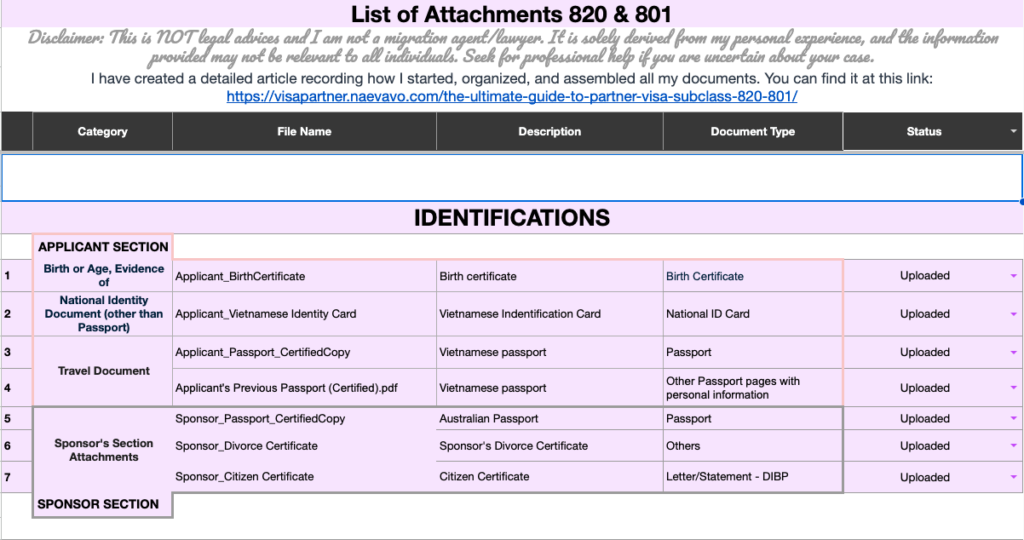
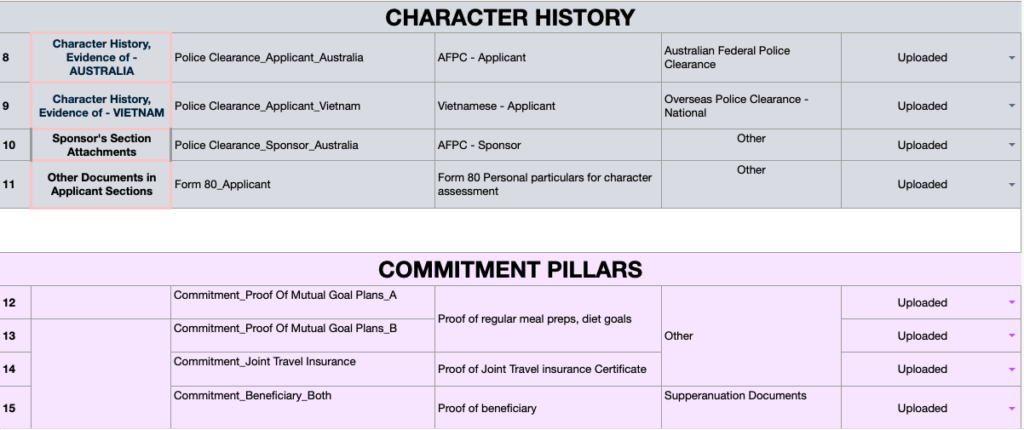
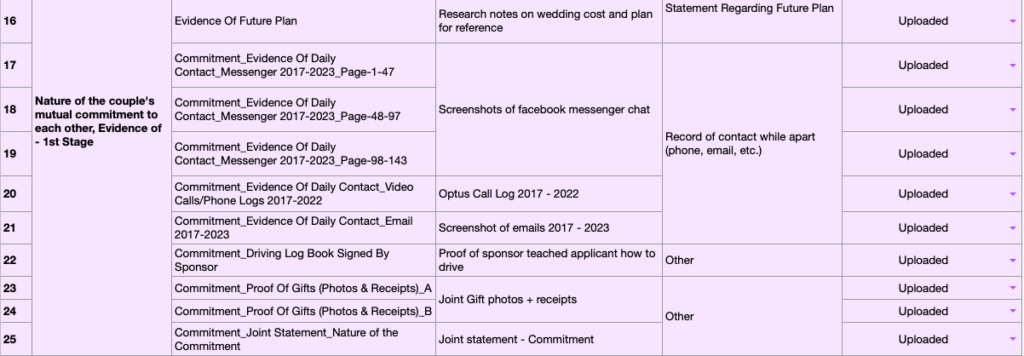
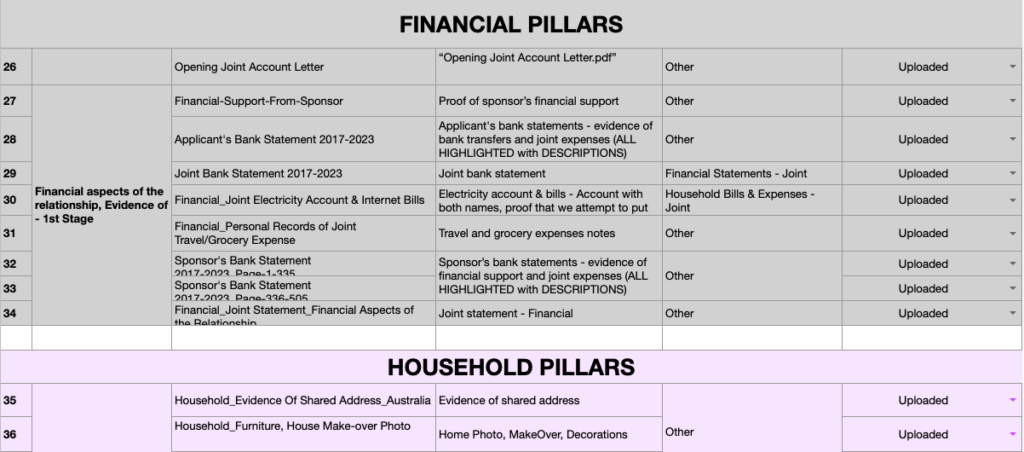
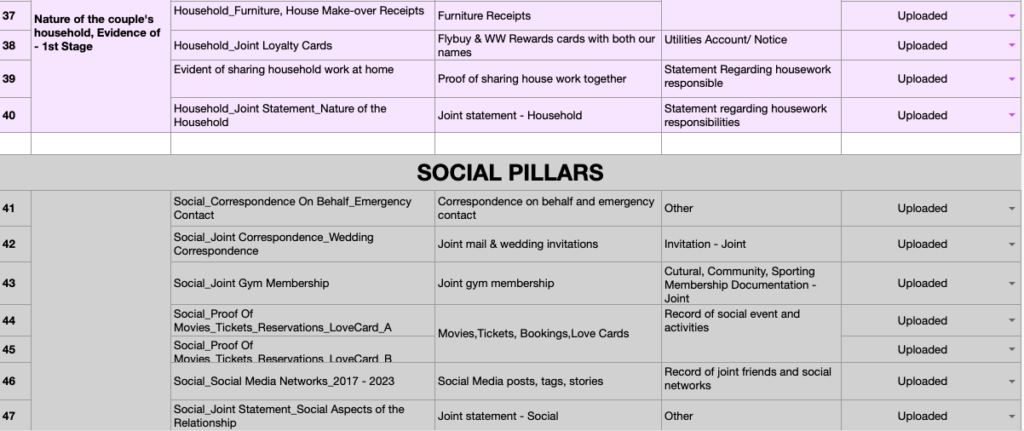
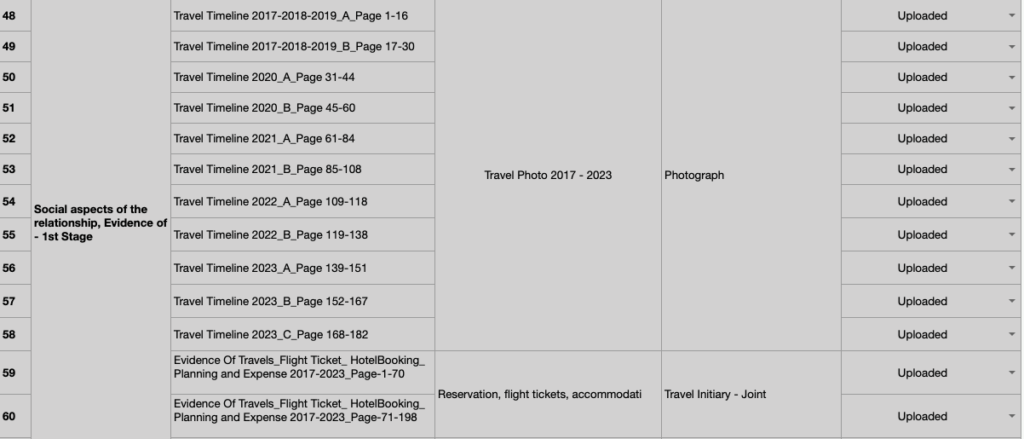
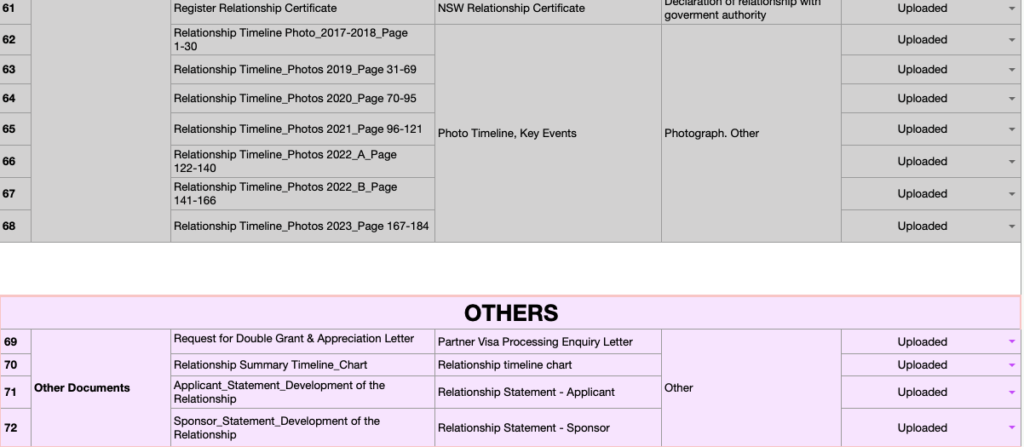
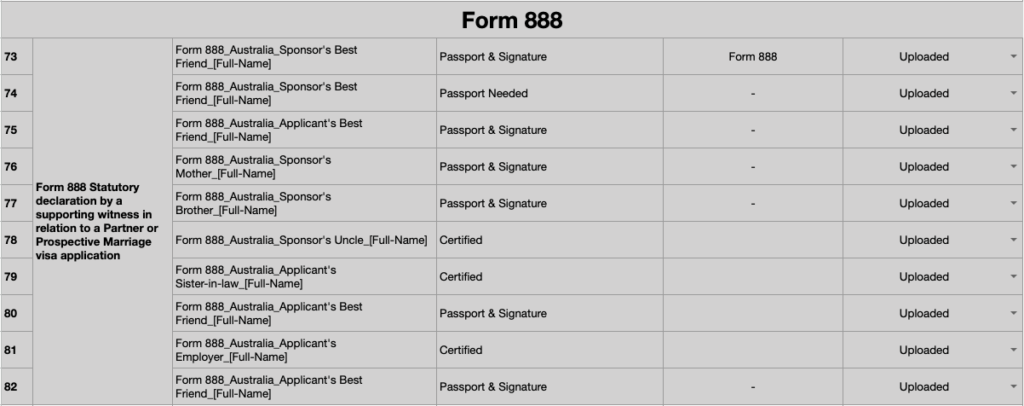
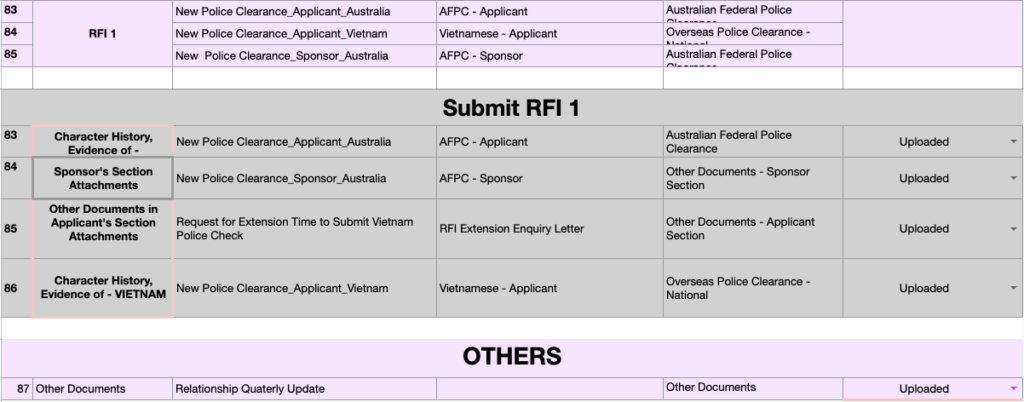

You Can Do This!
Looking back, the Partner Visa process was an emotional rollercoaster. There were moments of doubt, stress, and even frustration. But there were also moments where we sat back and realized how much we had built together as a couple. The visa process isn’t just about proving your relationship to immigration—it’s about celebrating your journey as a couple and showing how your lives have become intertwined.
If I could give one piece of advice to anyone starting this process, it’s to stay organized and stay updated
When my partner and I started our journey applying for the Partner Visa Subclass 820/801, we had no idea how complex and emotional the process would be. That’s why I decided to put together this eBook—because I know firsthand how overwhelming it can feel. In this guide, I’ve broken down everything we learned along the way: from collecting evidence to organizing documents and understanding what immigration really looks for. I’ve also included personal insights and tips that I wish someone had shared with me when we were applying. I hope this eBook can make your visa journey a little smoother and give you the confidence you need to submit a strong application.
If you’re tackling the Partner Visa process and feeling overwhelmed, my eBook and 1-on-1 Organizational Strategy Service are here to help. The eBook offers a 225 pages complete guide to structuring your application with templates, checklists, and real-life examples, making each step clear and manageable. And for those who want personalized guidance, my 1-on-1 Organizational Strategy Service is designed to support you in preparing a well-structured and organized visa application. This service focuses solely on helping you organize your documents, create effective timelines, and manage checklists so you can present your materials clearly.
Please note, this is not a legal or immigration advice service—our work together is all about the practical side of keeping your application organized and complete, without any legal consultation. My goal is to make the preparation process easier and less stressful so that you feel confident and ready!
- Check out the service here: https://visapartner.naevavo.com/book-appointment/
- Check out the digital product here: https://visapartner.naevavo.com/visa-hub/
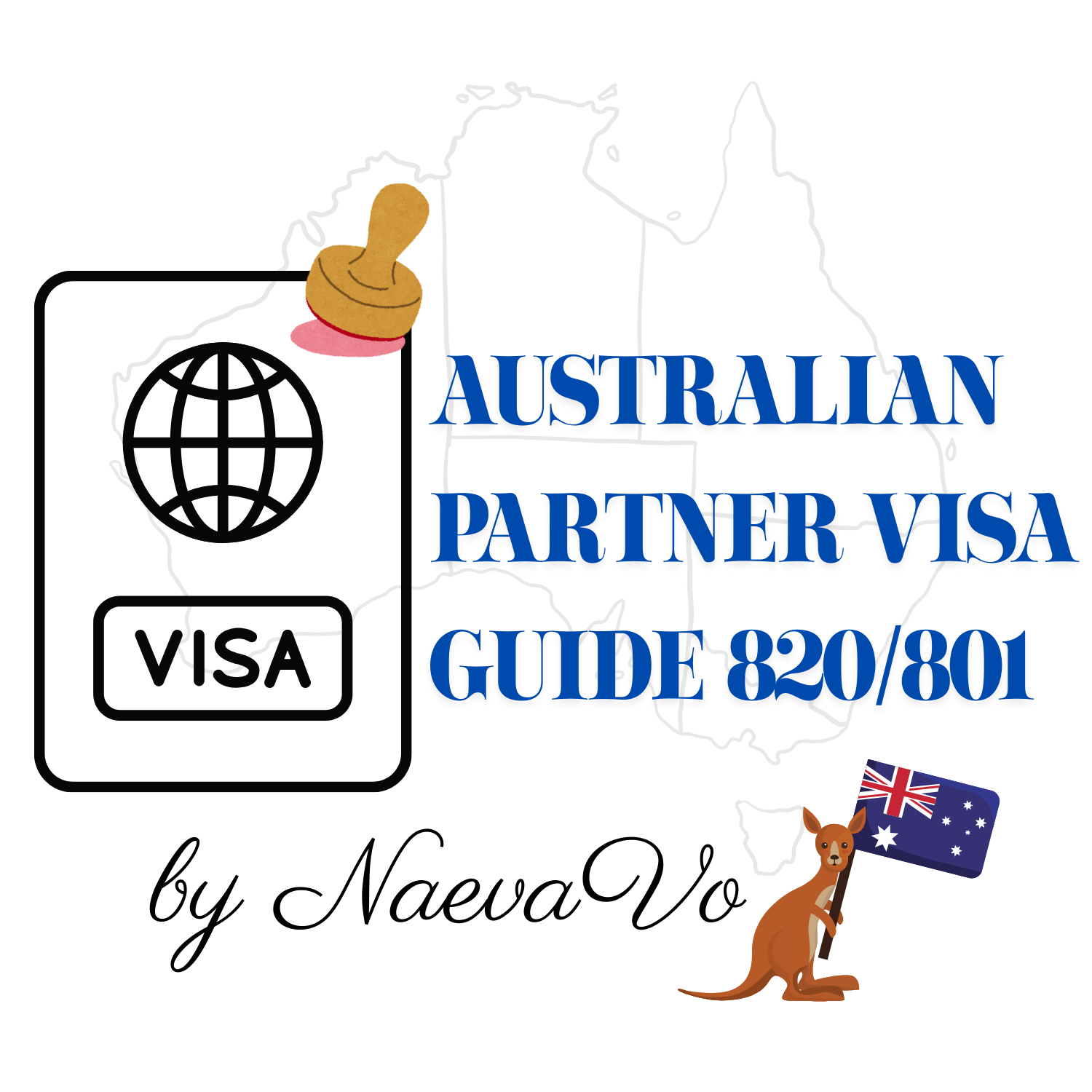
 )
)